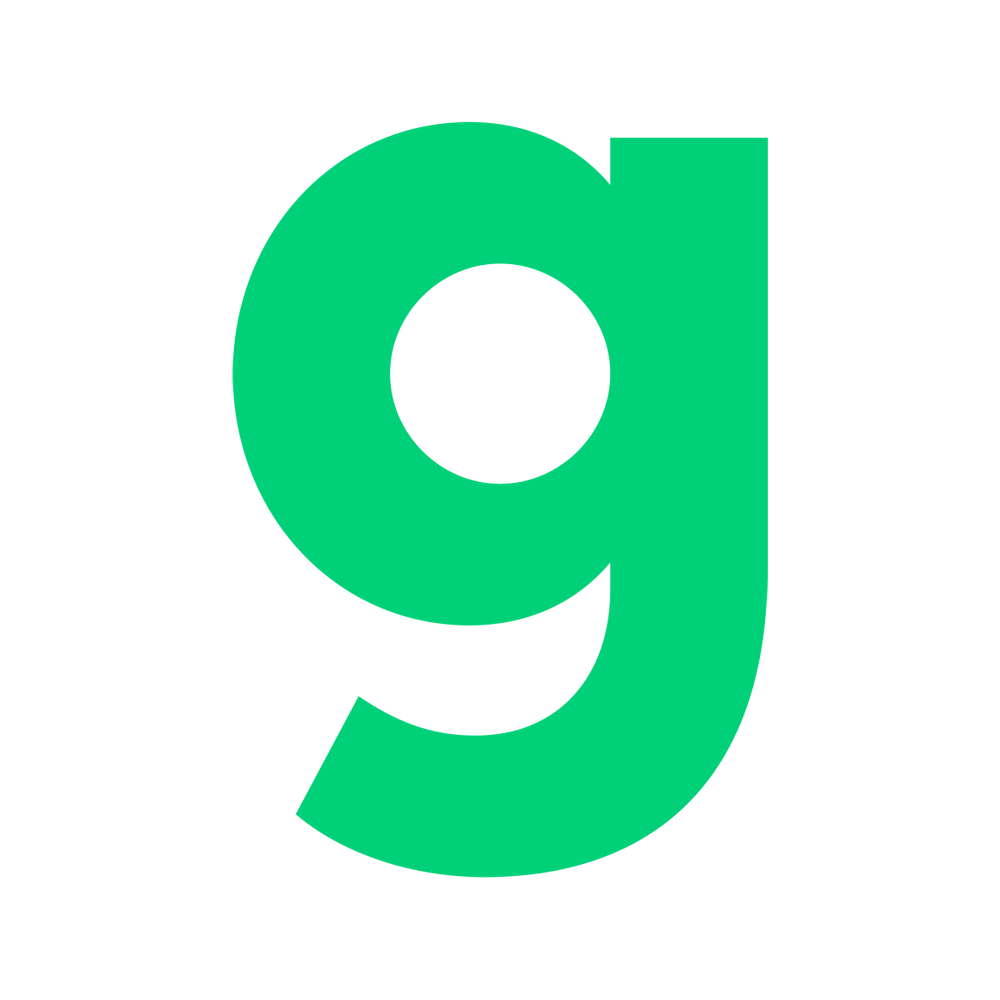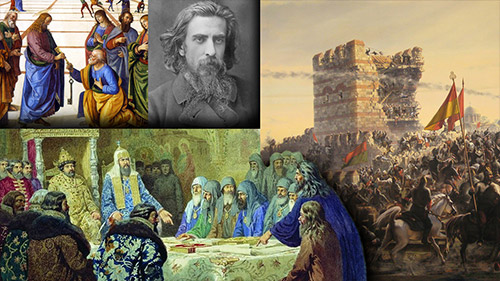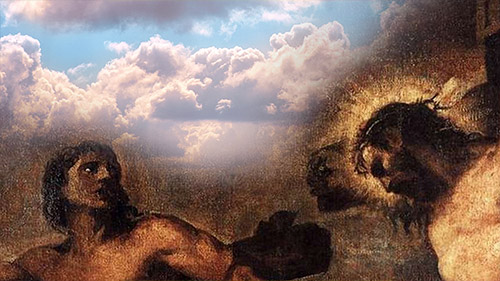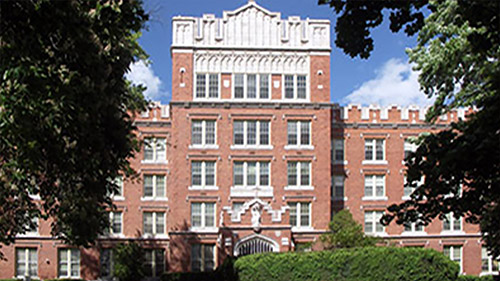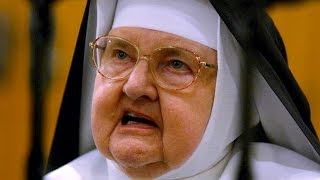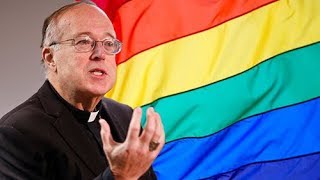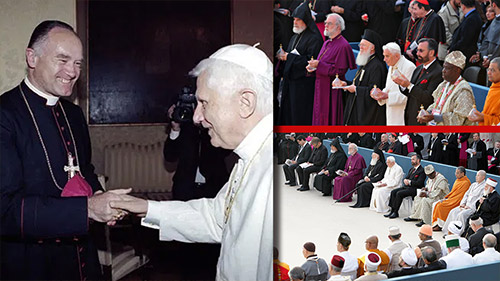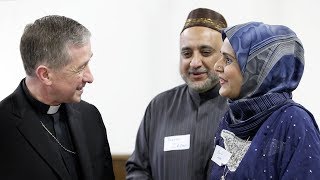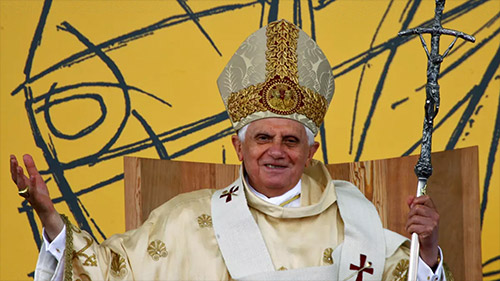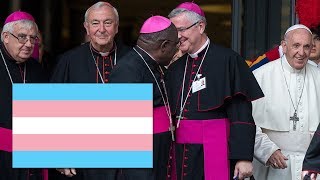 | vaticancatholic.com - English Channel |
Antipope Francis - Why He Is Not The Pope | Faith & Doctrine | Featured Videos | Heresies From The Vatican II Antipopes | John Paul II | Vatican II Church Is Not Catholic | Where Is The Catholic Church? Bro. Peter Dimond There are many heresies in Vatican II. This article will focus on one that’s very widespread and quite visible in the Vatican II Sect. (The video linked above contains abundant visual evidence for these points). As our material proves, the Vatican II Sect is not the Catholic Church but the prophesied end-times Counter Church. In number 8 of Vatican II’s decree on ecumenism, we read:
This passage of Vatican II endorses so-called ecumenical meetings with heretics and schismatics, such as with Protestants and the Eastern ‘Orthodox’, and it approves joint prayer with them at such meetings. This is directly contrary to what the Catholic Church has always taught, as we will see. This teaching of Vatican II is evil and heretical. In his 1928 encyclical Mortalium Animos, Pope Pius XI condemned so-called interreligious meetings and stated that the opinion on which they are based is tantamount to apostasy.
In that encyclical he also taught:
As we can see, the Catholic Church has never allowed Catholics to take part in the meetings or assemblies of non-Catholics. To actively assist or take part in non-Catholic worship is a mortal sin and a violation of the divine law. This divine law principle was also repeated in the 1917 Code of Canon Law. Canon 1258.1 states:
It’s important to understand why this activity is forbidden and what constitutes active participation in the religious rites of non-Catholics. A primary reason that many do not clearly see what the post-Vatican II crisis represents and what its false leaders are (i.e. heretical antipopes) is that they lack a pure faith and a foundational understanding of the relevant Catholic principles. Before we proceed, it should be noted that this video/article is about active participation in non-Catholic worship, or joining oneself to non-Catholic prayer or worship, which has always been forbidden. In this video we are not addressing mixed marriages, which were discouraged but tolerated on occasion, or receiving a sacrament from a non-Catholic in danger of death and similar things. Those kinds of communication did not constitute active participation in non-Catholic worship, which is never allowed. So don’t be deceived by dishonest defenders of Vatican II who sometimes confuse people by bringing up the previous kinds of communication with non-Catholics, which were at times permitted in Church history, as if they provided a precedent or a justification for the Vatican II Sect’s false teaching on active participation in non-Catholic worship, when they don’t at all. To briefly cover the relevant principles on this matter, I want to quote from a pre-Vatican II dissertation by canonist Fr. Ignatius Szal. It was published in 1948 by the Catholic University of America Press and with an imprimatur. We don’t agree with everything he says in the book, but he makes many good points and brings up relevant facts in articulating the Catholic Church’s perennial teaching that it’s forbidden to take part in any way in non-Catholic worship. In the following passages he’s primarily addressing communicatio in sacris (i.e. communication in religious things) with schismatics (such as with the Oriental dissidents or the Eastern ‘Orthodox’), but what he says applies to Protestants, Jews, Muslims, etc:
As we can see, various reasons render active assistance in non-Catholic worship gravely illicit. Such active religious communication is contrary to the divine law and tantamount to a false profession of faith, for it joins one to superstitious or illicit worship. It gives the false impression that the non-Catholic is approved in conducting illicit or false worship, and it almost always involves the additional sin of scandal. With these points in mind, an attentive person should immediately recognize what this means for the Vatican II Sect and its rampant false ecumenism. To illustrate how serious this is, according to canon 2316 of the 1917 Code, to engage in just one such act of active participation with heretics or to knowingly help the propagation of heresy makes one formally suspect of heresy; and if that person ignored warnings within six months he would be considered a heretic. But a person doesn’t have to receive or ignore canonical warnings to become a notorious heretic on this or other points. If a person repeatedly engages in non-Catholic worship against Catholic teaching and endorses such activity by repeated actions and/or public teaching, as the Vatican II Sect’s representatives do, that person is a notorious heretic (notorious in fact). The Catholic Church’s law on this matter concerns public acts of non-Catholic worship, and that is what we are discussing in this video. Let’s give a few specific examples of what constitutes active participation in non-Catholic worship. When non-Catholics conduct public prayer or worship, the following things (among others) constitute condemned active participation: joining in prayers with them; blessing them or giving joint ‘blessings’ with them; responding to their prayers; singing with them or singing alternately with them; giving them items such as candles, etc. that they use for worship or receiving similar objects from them; playing the organ or a musical instrument for their worship; participating in their scripture readings; carrying icons to their worship or place of worship; burning lamps during their worship or place of worship; and many similar things. All of these things have always been condemned by the Church. There are so many responses from Roman Congregations forbidding all such activities that if one were to cite them all this video would become very long. I will simply quote a few passages from Fr. Ignatius Szal about a few of these statements, so that people get a feel for how active participation in non-Catholic prayers or worship was condemned.
There were many other statements that prohibited any kind of activity that involved or signified a participation in non-Catholic worship. Various statements specifically from popes can also be cited.
Concerning the ‘Old Catholics’, who were heretics and schismatics who rejected Vatican I’s dogmatic definition of papal infallibility, Pope Pius IX stated the following.
Acts of communion with heretics were also denounced at the Fourth Council of Constantinople.
In 1791, Pope Pius VI stated the following about priests who had separated from the Church by accepting the heretical civil constitution of the clergy in France.
Now, the passage from Vatican II that we cited approves active participation in non-Catholic worship (which the Catholic church totally condemns) because the passage is about joining in prayers with non-Catholics during so-ecumenical meetings, at which non-Catholics conduct public prayer and worship according to their non-Catholic rites and sects. Thus, Vatican II’s teaching is indefensible, evil and heretical. It laid the foundation for the serial false ecumenism that is embraced, taught and exemplified by the Vatican II antipopes and in ‘dioceses’ all over the world. In short, the points we are covering prove that Vatican II’s false ecumenism is notorious heresy, and anyone who defends it is a heretic and a false teacher who leads people into mortal sin. Vatican II’s false teaching on joint prayer and worship with non-Catholics was endorsed by many subsequent statements of the antipopes, including Antipope John Paul II’s New Catechism, paragraph 1399; his first encyclical Redemptor Hominis #6; his encyclical Ut Unum Sint #21 and following; The Directory for the Application of Principles and Norms on Ecumenism; and much more.
In Ut Unum Sint, Antipope John Paul II goes on and on recommending and teaching the very thing that the Catholic Church always condemned, namely, joint worship with non-Catholics.
The Directory For The Application Of Principles And Norms On Ecumenism, promulgated in 1993 by John Paul II and the Council for ‘Promoting Christian Unity’, is one of the most astounding documents that the Vatican II Counter Church has produced. It’s essentially a manual for how to commit sins against the faith. It explicitly recommends the very actions that were specifically condemned by the Church.
As we’ve seen, this is condemned by Catholic teaching.
This is condemned by Catholic teaching. There are many other things we could cite, including how the Directory discourages Catholics from proselytizing non-Catholics. Concerning this notoriously heretical directory of sin, Antipope John Paul II stated in Ut Unum Sint:
This heretical Directory on Ecumenism, approved by Antipope John Paul II and the Council for Promoting Christian Unity, also makes it clear that it is implementing the teaching and principles of Vatican II.
It’s also interesting that when Pope Pius XI says that the Apostolic See has never allowed its subjects to take part in the meetings of non-Catholics, he uses the Latin word ‘conventibus’, which means meetings, assemblies or gatherings. Well, in directly contradicting Pius XI’s teaching, Vatican II uses the exact same word, ‘conventibus’, when it approved and recommended joint prayer at such meetings. There are so many examples – perhaps thousands – of the Vatican II Sect’s antipopes and its apostate so-called bishops and priests engaging in false ecumenism and condemned active participation in non-Catholic worship that it would take far too long to even cover a significant portion of them. It’s a regular occurrence in the Vatican II Counter Church. We have documented many of these incidents in our book, videos and articles over the years. However, I want to focus on just a few examples from Antipope John Paul II, Antipope Benedict XVI, and Antipope Francis. You will find much more on each of the antipopes in our material. In 1982 Antipope John Paul II took part in a joint service with the Anglican ‘Archbishop’ of Canterbury in Canterbury Cathedral. He and the notoriously heretical Anglican prayed together, prayed at the altar together, and even gave a ‘joint blessing’. That is a public mortal sin and an expression of heresy. In 1999 John Paul II went to Romania and took active part in the ‘Orthodox’ liturgy with Teoctist. That is a mortal sin and an expression of heresy. He met with Teoctist on various occasions and signed a joint declaration with him. In 1999 Teoctist also revealed that John Paul II gave him a donation for the construction of a cathedral, which turned out to be $100,000. In 2018 Francis did something similar, contributing 100,000 Euros toward the first ‘Orthodox’ monastery in Austria. Interestingly, on Jan. 29, 1828, the Sacred Congregation for the Propagation of the Faith declared it illicit to give alms for a schismatic church.
In 1983 John Paul II went to a Lutheran church to commemorate the 500th anniversary of the birth of the heretic Martin Luther. While there he and the Lutheran ‘pastor’ prayed together before the altar, ‘blessed’ the congregation simultaneously and together intoned a creed. That is public mortal sin and an expression of heresy. We could go and on with other examples of John Paul II’s active participation in non-Catholic worship with regard to heretics and schismatics, but he did it with pagans, Jews and Muslims as well. On April 13, 1986, John Paul II went to the Roman Synagogue, took part in the Jewish ceremony, and bowed his head as the Jews prayed for the coming of their ‘Messiah’. That’s an act of apostasy. Interestingly, St. Thomas Aquinas said that if anyone were to worship at the tomb of Muhammad, he would be deemed an apostate. (Summa Theologiae, Secunda Secundae, Q. 12, A. 2, Obj. 2. This is cited in Obj. 2, and in St. Thomas’ response to Obj. 2 he doesn’t disagree with the statement that such an action would be apostasy.) Worshipping at the tomb of Muhammad would be apostasy because to participate in non-Catholic forms of worship is tantamount to a profession of faith in those false religions, as we’ve covered. John Paul II and various Vatican II antipopes regularly committed acts of apostasy of this kind. Remember, heresy and apostasy can be manifested by deed as well as by word. John Paul II would frequently receive ‘blessings’ from pagans. On August 8, 1985, John Paul II prayed with African Animists (witch doctors). John Paul II recalled the meeting:
That’s apostasy. In Cotonou, Africa, on Feb. 4, 1993, chanting girls treated John Paul II to a “trance inducing” Voodoo dance. John Paul II also organized the Assisi events and took active part in them. By organizing the Assisi events, and by his active participation in them, John Paul II joined himself to the false worship of all the different religions at Assisi. It was a public mortal of the highest order and an expression of apostasy. John Paul II’s career was characterized by indifferentism and participation in false forms of worship. Of course, such a public heretic and a public mortal sinner could not be a Catholic pope, let alone a saint. That’s one reason that the veneration of his image, by means of his invalid canonization, is mentioned in the Apocalypse, as our material covers. When deceived members of the Vatican II Counter Church accept the notoriously wicked apostate Antipope John Paul II as a saint – a man whose career was characterized by indifferentism, public mortal sins against the faith, and participation in false religious worship – they become implicated in his sins. Online commentators and others who consider John Paul II to be a saint are clueless, deceived, and on the road to Hell. It’s also noteworthy that in Ut Unum Sint, John Paul II admits that his mortally sinful acts of prayer and worship with heretics and schismatics are based directly on Vatican II.
We could cover much more from Antipope John Paul II, but let’s move on to Benedict XVI. Benedict XVI regularly took part in non-Catholic worship. On August 19, 2005, he took active part in a Jewish Synagogue in Cologne, Germany. He joined the Jews in the Kaddish prayer and made many gestures which displayed his active participation. That is apostasy. On Nov. 30, 2006, Benedict XVI prayed like Muslims toward Mecca in the Blue Mosque in Turkey. He even crossed his arms in the Muslim prayer gesture called “the gesture of tranquility”. That is apostasy. On Sept. 23, 2011, Benedict XVI visited a Lutheran church in Erfurt, Germany. While there he praised Martin Luther and took active part in a Lutheran service. He jointly ‘blessed’ the people with the Lutheran ‘pastor’ and even prayed with a female Lutheran ‘bishop’. He bowed at the Lutheran altar. That is a public mortal sin and an expression of notorious heresy. On Sept. 17, 2010, Benedict XVI took part in an Anglican Service in Westminster Abbey with the pro-homosexual Anglican ‘Archbishop’ Rowan Williams. They processed into the Protestant church together, they prayed together, and they gave a joint ‘blessing’. That is a manifestation of a false religion. Benedict XVI held his own abominable Assisi event in 2011. He not only took active part in that event of apostasy, but as the host and organizer he thereby joined himself to the false worship of all the pagans, heretics, etc. who conducted false worship at that event. We could give many other examples of Benedict XVI’s mortally sinful participation in false worship. It’s not only something he did often, it’s something he explicitly approved with his words. On Jan. 18, 2008, in an address to a Finnish ecumenical delegation, Benedict XVI praised joint prayer between Lutherans and Catholics and stated that this is the royal door of ecumenism.
So, the activity that the Catholic Church has always condemned as gravely sinful, Benedict XVI says is the path to follow. He is a notorious heretic. False traditionalists who think that the notorious heretic Benedict XVI was conservative or is the true pope are very deceived. He was an apostate antipope. For more on him, see our video The Heresies of Benedict XVI and our articles on his heresies, based on research of 30 of his books and all of his speeches. The apostate antipope Francis frequently participates in false non-Catholic worship. On Nov. 29, 2014, Francis prayed alongside the Mufti in Istanbul’s Blue Mosque. That is apostasy. On January 17, 2016, he went to the synagogue in Rome, took active part in the Jewish service, uttered various heretical things, and said: “Let us pray together to the Lord”. That is apostasy. We could give many other examples of Antipope Francis participating in the false worship of pagans, Jews, Protestants, and the schismatic ‘Orthodox’. (See the attached video.) In addition to his actions, Francis praises joint prayer with non-Catholics and he has explicitly mentioned “interreligious prayer”. His position on this matter, which contradicts what the Catholic Church teaches, is proven to be heretical by his words and by his deeds. The fact that the Vatican II antipopes repeatedly engage in this behavior and teach that it is good proves without any doubt that they are notorious heretics. This sinful activity is also engaged in by many apostate ‘bishops’ of the Vatican II Sect. Simply put, false ecumenism is a giant heresy that is tantamount to denying the dogma that the Catholic Church is the one true Church of Jesus Christ, which is necessary for salvation, and that non-Catholic religions are false and sinful and lead to damnation. This heresy (that it’s good to participate in non-Catholic worship) was taught directly in Vatican II, as we’ve proven in this video. It should also be noted that the divinely revealed truth that is denied by Vatican II’s teaching on joint prayer and worship with non-Catholics is found in 2 John 1:10-11:
This passage was cited by the Church in the context of condemning any participation in non-Catholic meetings or assemblies (Pope Pius XI, Mortalium Animos #9, Jan. 6, 1928). Hence, Vatican II’s evil teaching is properly speaking heretical. It denies the divinely revealed truth of 2 John 1:10-11. It teaches, contrary to Scripture, that it’s good and desirable to take part in the wicked works and illicit or false worship of heretics and schismatics. Since the false ecumenism of the Vatican II Sect comes from Vatican II, as we’ve shown, anyone who obstinately defends Vatican II is a spiritual fornicator and a heretic. All of the non-sedevacantist groups under the Vatican II antipopes, such as the Fraternity of St. Peter, are composed of phonies. If they actually possessed and stood for the faith, they would reject this mortally sinful heresy and the heretical antipopes who promote it. They have no love for God. In the face of these facts, some faithless people, who claim to be Catholic, will say: if I accepted this, I’d have to reject Catholicism. No, you are wrong, and you don’t have any faith. The Catholic Church is the one true Church and this entire situation was prophesied. The men who ushered in this apostasy were heretical antipopes, according to Catholic teaching. They never validly assumed the papal office, as our material proves, because a heretic is barred by divine law from becoming pope. What these facts prove is that the Vatican II Sect is not the Catholic Church and that its leaders have been antipopes. The Vatican II Sect is indeed the prophesied Whore of Babylon. It fulfills prophecies about the Whore of Babylon and the Beast in many specific ways. See our video Apocalypse Now In The Vatican. The false ecumenism that we’ve exposed in this article/video is one reason that the Whore of Babylon is called the mother of the fornications (Apocalypse 17:5). False ecumenism is the means by which people are implicated in sins against the faith, as part of the end-times deception. Even if you don’t engage in false ecumenism directly, if you accept the Vatican II antipopes and their false canonizations you are implicated in it. The true Catholic Church still exists in a faithful remnant, and to be a true Catholic and save your soul you need to be a traditional Catholic who rejects the apostate Vatican II Sect and the false Second Vatican Council. Copyright © 2022 Most Holy Family Monastery |
Vatican II Is A New Religion (Visual Proof)
January 5, 2022
SHOW MORE
Latest News
Dr. Leonard Coldwell attacks statin drugs - He says it's a scam - video
"Covid-19" - A fake virus to convince people to take bioweapon "vaccine" to reduce the world's population
"Covid vaccine" reduces fertility 33% - Billions took the poison and you have a 33% reduction in fertility
Who were the main people running the Covid hoax operation? - video
Family says daughter in hospital for "Covid" was given drugs & DNR (Do Not Resuscitate) order that killed her

